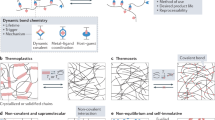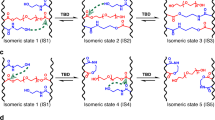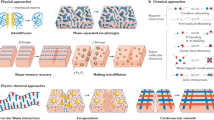Abstract
New materials that have the ability to reversibly adapt to their environment and possess a wide range of responses ranging from self-healing to mechanical work are continually emerging. These adaptive systems have the potential to revolutionize technologies such as sensors and actuators, as well as numerous biomedical applications. We will describe the emergence of a new trend in the design of adaptive materials that involves the use of reversible chemistry (both non-covalent and covalent) to programme a response that originates at the most fundamental (molecular) level. Materials that make use of this approach — structurally dynamic polymers — produce macroscopic responses from a change in the material's molecular architecture (that is, the rearrangement or reorganization of the polymer components, or polymeric aggregates). This design approach requires careful selection of the reversible/dynamic bond used in the construction of the material to control its environmental responsiveness.
This is a preview of subscription content, access via your institution
Access options
Subscribe to this journal
Receive 12 print issues and online access
$259.00 per year
only $21.58 per issue
Buy this article
- Purchase on Springer Link
- Instant access to full article PDF
Prices may be subject to local taxes which are calculated during checkout








Similar content being viewed by others
References
Rowan, S. J., Cantrill, S. J., Cousins, G. R. L., Sanders, J. K. M. & Stoddart, J. F. Dynamic covalent chemistry. Angew. Chem. Int. Ed. 41, 898–952 (2002).
Lehn, J. M. From supramolecular chemistry towards constitutional dynamic chemistry and adaptive chemistry. Chem. Soc. Rev. 36, 151–160 (2007).
Corbett, P. T. et al. Dynamic combinatorial chemistry. Chem. Rev. 106, 3652–3711 (2006).
Maeda, T., Otsuka, H. & Takahara, A. Dynamic covalent polymers: reorganizable polymers with dynamic covalent bonds. Prog. Polym. Sci. 34, 581–604 (2009).
Ciferri, A. (ed.) Supramolecular Polymers 2nd edn (CRC Press, 2005).
Brunsveld, L., Folmer, B. J. B., Meijer, E. W. & Sijbesma, R. P. Supramolecular polymers. Chem. Rev. 101, 4071–4098 (2001).
Fox, J. D. & Rowan, S. J. Supramolecular polymerizations and main-chain supramolecular polymers. Macromolecules 42, 6823–6835 (2009).
De Greef, T. F. A. et al. Supramolecular polymerizations. Chem. Rev. 109, 5687–5754 (2009).
Cohen Stuart, M. A. et al. Emerging applications of stimuli-responsive polymer materials. Nature Mater. 9, 101–113 (2010).
Bar-Cohen, Y. Electroactive Polymer (EAP) Actuators as Artificial Muscles: Reality, Potential, and Challenges (SPIE, 2001).
Liu, F. & Urban, M. W. Recent advances and challenges in designing stimuli-responsive polymers. Prog. Polym. Sci. 35, 3–23 (2010).
Vaia, R. & Baur, J. Adaptive composites. Science 319, 420–421 (2008).
Otto, S., Furlan, R. L. E. & Sanders, J. K. M. Dynamic combinatorial chemistry. Drug Discov. Today. 7, 117–125 (2002).
Ramström, O. & Lehn, J. M. Drug discovery by dynamic combinatorial libraries. Nature Rev. Drug Discov. 1, 26–36 (2002).
Sadownik, J. W. & Ulijn, R. V. Locking an oxidation-sensitive dynamic peptide system in the gel state. Chem. Commun. 3481–3483 (2010).
Bergman, S. D. & Wudl, F. Mendable polymers. J. Mater. Chem. 18, 41–62 (2008).
Otsuka, H., Aotani, K., Higaki, Y., Amamoto, Y. & Takahara, A. Thermal reorganization and molecular weight control of dynamic covalent polymers containing alkoxyamines in their main chains. Macromolecules 40, 1429–1434 (2007).
Higaki, Y., Ostuka, H. & Takahara, A. A thermodynamic polymer cross-linking system based on radically exchangeable covalent bonds. Macromolecules 39, 2121–2125 (2006).
Amamoto, Y., Higaki, Y., Matsuda, Y., Otsuka, H. & Takahara, A. Programmed thermodynamic formation and structure analysis of star-like nanogels with core cross-linked by thermally exchangeable dynamic covalent bonds. J. Am. Chem. Soc. 129, 13298–13304 (2007).
Amamoto, Y. et al. Intelligent build-up of complementarily reactive diblock copolymers via dynamic covalent exchange toward symmetrical and miktoarm star-like nanogels. Macromolecules 43, 1785–1791 (2010).
Kloxin, C. J., Scott, T. F., Adzima, B. J. & Bowman, C. N. Covalent adaptable networks (CANs): a unique paradigm in cross-linked polymers. Macromolecules 43, 2643–2653 (2010).
Amamoto, Y. et al. Reorganizable chemical polymer gels based on dynamic covalent exchange and controlled monomer insertion. Macromolecules 42, 8733–8738 (2009).
Sontjens, S. H. M., Sijbesma, R. P., vanGenderen, M. H. P. & Meijer, E. W. Stability and lifetime of quadruply hydrogen bonded 2-ureido-4[1H]-pyrimidinone dimers. J. Am. Chem. Soc. 122, 7487–7493 (2000).
Folmer, B. J. B., Sijbesma, R. P., Versteegen, R. M., van der Rijt, J. A. J. & Meijer, E. W. Supramolecular polymer materials: chain extension of telechelic polymers using a relative hydrogen-bonding synthon. Adv. Mater. 12, 874–878 (2000).
Wu, D. Y., Meure, S. & Solomon, D. Self-healing polymeric materials: A review of recent developments. Prog. Polym. Sci. 33, 479–522 (2008).
Murphy, E. B. & Wudl, F. The world of smart healable materials. Prog. Polym. Sci. 35, 223–251 (2010).
Wool, R. P. Self-healing materials: a review. Soft Matter 4, 400–418 (2008).
van der Zwaag, S. Self Healing Materials: An Alternative Approach to 20 Centuries of Material Science (Springer, 2008).
Burattini, S., Greenland, B. W., Chappell, D., Colquhoun, H. M. & Hayes, W. Healable polymeric materials: a tutorial review. Chem. Soc. Rev. 39, 1973–1985 (2010).
Toohey, K. S., Sottos, N. R., Lewis, J. A., Moore, J. S. & White, S. R. Self-healing materials with microvascular networks. Nature Mater. 6, 581–585 (2007).
White, S. R. et al. Autonomic healing of polymer composites. Nature 409, 794–797 (2001).
Ghosh, B. & Urban, M. W. Self-reparing oxetane-substituted chitosan polyurethane networks. Science 323, 1458–1460 (2009).
Cordier, P., Tournilhac, F., Soulie-Ziakovic, C. & Leibler, L. Self-healing and thermoreversible rubber from supramolecular assembly. Nature 51, 977–980 (2008).
Mynar, J. L. & Aida, T. Materials science: The gift of healing. Nature 451, 895–896 (2008).
Burattini, S., Colquhoun, H. M., Greenland, B. W. & Hayes, W. A novel self-healing supramolecular polymer system. Faraday Discuss. 143, 251–264 (2009).
Burattini, S. et al. A self-repairing, supramolecular polymer system: healability as a consequence of donor-acceptor pi-pi stacking interactions. Chem. Commun. 6717–6719 (2009).
Burattini, S. et al. A healable supramolecular polymer blend based on aromatic π−π stacking and hydrogen-bonding interactions. J. Am. Chem. Soc. 132, 12051–12058 (2010).
Adzima, B. J., Aguirre, H. A., Kloxin, C. J., Scott, T. F. & Bowman, C. N. Rheological and chemical analysis of reverse gelation in a covalently cross-linked Diels-Alder polymer network. Macromolecules 41, 9112–9117 (2008).
Carey, F. A. & Sundberg, R. J. Advanced Organic Chemistry Part A: Structure and Mechanisms 5th edn (Springer, 2007).
Chen, X. et al. A thermally re-mendable cross-linked polymeric material. Science 295, 1698–1702 (2002).
Murphy, E. B. et al. Synthesis and characterization of a single-component thermally remendable polymer network; Staudinger and Stille revisited. Macromolecules 41, 5203–5209 (2008).
Reutenauer, P., Buhler, E., Boul, P. J., Candau, S. J. & Lehn, J. M. Room temperature dynamic polymers based on Diels-Alder chemistry. Chem. Eur. J. 15, 1893–1900 (2009).
Lendlein, A. & Kelch, S. Shape-memory polymers. Angew. Chem. Int. Ed. 41, 2034–2057 (2002).
Li, J., Viveros, J. A., Wrue, M. H. & Anthamatten, M. Shape-memory effects in polymer networks containing reversibly associating side-groups. Adv. Mater. 19, 2851–2855 (2007).
Skene, W. G. & Lehn, J. M. Dynamers: polyacylhydrazone reversible covalent polymers, component exchange, and constitutional diversity. Proc. Natl Acad. Sci. USA 101, 8270–8275 (2004).
Ono, T., Fujii, S., Nobori, T. & Lehn, J. M. Soft-to-hard transformation of the mechanical properties of dynamic covalent polymers through component incorporation. Chem. Commun. 46–48 (2007).
Ono, T., Nobori, T. & Lehn, J. M. Dynamic polymer blends-component recombination between neat dynamic covalent polymers at room temperature. Chem. Commun. 1522–1524 (2005).
Ono, T., Fujii, S., Nobori, T. & Lehn, J. M. Optodynamers: expression of color and fluorescence at the interface between two films of different dynamic polymers. Chem. Commun. 4360–4362 (2007).
Beck, J. B. ; Ineman, J. M. & Rowan, S. J. Metal/ligand-induced formation of metallo-supramolecular polymers. Macromolecules 38, 5060–5068 (2005).
Kumpfer, J. R., Jin, J. & Rowan, S. J. Stimuli-responsive europium-containing metallo-supramolecular polymers. J. Mater. Chem. 20, 145–151 (2010).
Fratzl, P. Biomimetic materials research: what can we really learn from nature's structural materials? J. R. Soc. Interface 4, 637–642 (2007).
Sun, T., Feng, L., Gao, X. & Jiang, L. Bioinspired surfaces with special wettability. Acc. Chem. Res. 38, 644–652 (2005).
Vincent, J. F. V. Biomimetic materials. J. Mater. Res. 23, 3140–3147 (2008).
Trotter, J. A. et al. Towards a fibrous composite with dynamically controlled stiffness: lessons from echinoderms. Biochem. Soc. Trans. 28, 357–362 (2000).
Trotter, J. A. & Koob, T. J. Collagen fibril aggregation-inhibitor from sea cucumber dermis. Matrix Biol. 18, 569–578 (1999).
Szulgit, G. K. & Shadwick, R. E. Dynamic mechanical characterizations of a mutable collagenous tissue: response of sea cucumber dermis to cell lysis and dermal extracts. J. Exp. Biol. 203, 1539–1550 (2000).
Alberts, B. et al. Molecular Biology of the Cell 3rd edn (Garland Science, 1994).
Capadona, J. R., Shanmuganathan, K., Tyler, D. J., Rowan, S. J. & Weder, C. Stimuli-responsive polymer nanocomposites inspired by the sea cucumber dermis. Science 319, 1370–1374 (2008).
Shanmuganathan, K., Capadona, J. R., Rowan, S. J. & Weder, C. Stimuli-responsive mechanically adaptive polymer nanocomposites. ACS Appl. Mater. Interfaces 2, 165–174 (2010).
Shanmuganathan, K., Capadona, J. R., Rowan, S. J. & Weder, C. Bio-inspired mechanically-adaptive nanocomposites derived from cotton cellulose whiskers. J. Mater. Chem. 20, 180–186 (2010).
Shanmuganathan, K., Capadona, J. R., Rowan, S. J. & Weder, C. Biomimetic mechanically adaptive nanocomposites. Prog. Polym. Sci. 35, 212–222 (2010).
Osada, Y. & Gong, J. P. Soft and wet materials: Polymer gels. Adv. Mater. 10, 827–837 (1998).
Sangeetha, N. M. & Maitra, U. Supramolecular gels: functions and uses. Chem. Soc. Rev. 34, 821–836 (2005).
Ashton, P. R. et al. Dialkylammonium ion/crown ether complexes: the forerunners of a new family of interlocked molecules. Angew. Chem. Int. Ed. 34, 1865–1869 (1995).
Ge, Z., Hu, J., Huang, F. & Liu, S. Responsive supramolecular gels constructed by crown ether based molecular recognition. Angew. Chem. Int. Ed. 48, 1798–1802 (2009).
Oku, T., Furusho, Y. & Takata, T. A concept for recyclable cross-linked polymers: topologically networked polyrotaxane capable of undergoing reversible assembly and disassembly. Angew. Chem. Int. Ed. 43, 966–969 (2004).
Endo, T., Suzuki, T., Sanda, F. & Takata, T. A novel approach for the chemical recycling of polymeric materials: The network polymer reversible-bifunctional monomer reversible system. Macromolecules 29, 3315–3316 (1996).
Deng, G., Tang, C., Li, F., Jiang, H. & Chen, Y. Covalent cross-linked polymer gels with reversible sol-gel transition and self-healing properties. Macromolecules 43, 1191–1194 (2010).
Beyer, M. K. & Clausen-Schaumann, H. Mechanochemistry: the mechanical activation of covalent bonds. Chem. Rev. 105, 2921–2948 (2005).
Tskhovrebova, L. & Trinick, J. Titin: properties and family relationships. Nature Rev. Mol. Cell Biol. 4, 679–689 (2003).
Smith, B. L. et al. Molecular mechanistic origin of the toughness of natural adhesives, fibres and composites. Nature 399, 761–763 (1999).
Kushner, A. M., Vossler, J. D., Williams, G. A. & Guan, Z. A biomimetic modular polymer with tough and adaptive properties. J. Am. Chem. Soc. 131, 8766–8768 (2009).
Guan, Z. et al. Modular domain structure: a biomimetic strategy for advanced polymeric materials. J. Am. Chem. Soc. 126, 2058–2065 (2004).
Hickenboth, C. R. et al. Biasing reaction pathways with mechanical force. Nature 446, 423–427 (2007).
Potisek, S. L., Davis, D. A., Sottos, N. R., White, S. R. & Moore, J. S. Mechanophore-linked addition polymers. J. Am. Chem. Soc. 129, 13808–13809 (2007).
Löwe, C. & Weder, C. Oligo(p-phenylene vinylene) excimers as molecular probes: deformation-induced color changes in photoluminescent polymer blends. Adv. Mater. 14, 1625–1629 (2002).
Kunzelman, J., Crenshaw, B. R., Kinami, M. & Weder, C. Self-assembly and dispersion of chromogenic molecules: a versatile and general approach for self-assessing polymers. Macromol. Rapid Commun. 27, 1981–1987 (2006).
Sing, C. E., Kunzelman, J. & Weder, C. Time-temperature indicators for high temperature applications. J. Mater. Chem. 19, 104–110 (2009).
Lott, J. & Weder, C. Luminescent mechanochromic sensors based on poly(vinyldene fluoride) and excimer- forming p-phenylene vinylene dyes. Macromol. Chem. Phys. 211, 28–34 (2010).
Kinami, M., Crenshaw, B. R. & Weder, C. Polyesters with built-in threshold temperature and deformation sensors. Chem. Mater. 18, 946–955 (2006).
Tyson, D. A., Carbaugh, A. D., Ilhan, F., Santos-Pérez, J. & Meador, M. A. Novel anthracene diimide fluorescent sensor. Chem. Mater. 20, 6595–6596 (2008).
Davis, D. A. et al. Force-induced activation of covalent bonds in mechanoresponsive polymeric materials. Nature 459, 68–72 (2009).
Paulusse, J. M. J. & Sijbesma, R. P. Ultrasound in polymer chemistry: revival of an established technique. J. Polym. Sci. A 44, 5445–5453 (2006).
Basedow, A. M. & Ebert, K. H. Ultrasonic degradation of polymer in solution. Adv. Polym. Sci. 22, 83–148 (1977).
Paulusse, J. M. J. & Sijbesma, R. P. Reversible mechanochemistry of a PdII coordination polymer. Angew. Chem. Int. Ed. 43, 4460–4462 (2004).
Paulusse, J. M. J., Huijbers, J. P. J. & Sijbesma, R. P. Quantification of ultrasound-induced chain scission in PdII–phosphine coordination polymers. Chem. Eur. J. 12, 4928–4934 (2006).
Paulusse, J. M. J., van Beek, D. J. M. & Sijbesma, R. P. Reversible switching of the sol-gel transition with ultrasound in rhodium(I) and iridium(I) coordination networks. J. Am. Chem. Soc. 129, 2392–2397 (2007).
Piermattei, A., Karthikeyan, S. & Sijbesma, R. P. Activating catalysts with mechanical force. Nature Chem. 1, 133–137 (2009).
Caruso, M. M. et al. Mechanically induced chemical changes in polymers. Chem. Rev. 109, 5755–5798 (2009).
Berkowski, K. L., Potisek, S. L., Hickenboth, C. R. & Moore, J. S. Ultrasound-induced site-specific cleavage of azo-functionalized poly(ethylene glycol). Macromolecules 38, 8975–8978 (2005).
Zhang, L. & Tam, J. P. Synthesis and application of unprotected cyclic peptides as building blocks for peptide dendrimers. J. Am. Chem. Soc. 119, 2363–2370 (1997).
Caraballo, R., Rahm, M., Vongvilai, P., Brinck, T. & Ramström, O. Phosphine-catalyzed disulfide metathesis. Chem. Commun. 6603–6605 (2008).
Arisawa, M. & Yamaguchi, M. Rhodium-catalyzed disulfide exchange reaction. J. Am. Chem. Soc. 125, 6624–6625 (2003).
Otsuka, H., Nagano, S., Kobashi, Y., Maeda, T. & Takahara, A. A dynamic covalent polymer driven by disulfide metathesis under photoirradiation. Chem. Commun. 1150–1152 (2010).
Trenor, S. R., Shultz, A. R., Love, B. J. & Long, T. E. Coumarins in polymers: from light harvesting to photo-cross-linkable tissue scaffolds. Chem. Rev. 104, 3059–3077 (2004).
Zheng, Y. et al. PEG-based hydrogel synthesis via the photodimerization of anthracene groups. Macromolecules 35, 5228–5234 (2002).
Chujo, Y., Sada, K., Nomura, R., Naka, A. & Saegusa, T. Photogelation and redox properties of anthracene-disulfide-modified polyoxazolines. Macromolecules 26, 5611–5614 (1993).
Chujo, Y., Sada, K. & Saegusa, T. Polyoxazoline having a coumarin moiety as a pendant group: synthesis and photogelation. Macromolecules 23, 2693–2697 (1990).
Chen, Y. & Geh, J. L. Copolymers derived from 7-acryloyloxy-4-methylcoumarin and acrylates: 1. Copolymerizibility and photocrosslinking behaviours. Polymer 20, 4473–4480 (1996).
Connal, L. A., Vestberg, R., Hawker, C. J. & Qiao, G. G. Fabrication of reversibly crosslinkable, 3-dimensionally conformal polymeric microstructures. Adv. Funct. Mater. 18, 3315–3322 (2008).
Scott, T. F., Schneider, A. D., Cook, W. D. & Bowman, C. N. Photoinduced plasticity in cross-linked polymers. Science 308, 1615–1617 (2005).
Long, K. N., Scott, T. F., Qi, H. J., Bowman, C. N. & Dunn, M. L. Photomechanics of light-activated polymers. J. Mech. Phys. Solids 57, 1103–1121 (2009).
Guo, D. S., Chen, S., Qian, H., Zhang, H. Q. & Liu, Y. Electrochemical stimulus-responsive supramolecular polymer based on sulfonatocalixarene and viologen dimers. Chem. Commun. 2620–2622 (2010).
Chujo, Y., Sada, K., Naka, A., Nomura, R. & Saegusa, T. Synthesis and redox gelation of disulfide-modified polyoxazoline. Macromolecules 26, 883–887 (1993).
Vogt, A. P. & Sumerlin, B. S. Temperature and redox responsive hydrogels from ABA triblock copolymers prepared by RAFT polymerization. Soft Matter 5, 2347–2351 (2009).
Kolomiets, E. & Lehn, J.-M. Double dynamers: molecular and supramolecular double dynamic polymers. Chem. Commun. 1519–1521 (2005).
ten Cate, A. T., Dankers, P. Y. W., Sijbesma, R. P. & Meijer, E. W. Disulfide exchange in hydrogen-bonded cyclic assemblies: Stereochemical self-selection by double dynamic chemistry. J. Org. Chem. 70, 5799–5803 (2005).
von Delius, M., Geertsema, E. M. & Leigh, D. A. A synthetic small molecule that can walk down a track. Nature Chem. 2, 96–101 (2010).
Wang, C. et al. Multistimuli responsive organogels based on a new gelator featuring tetrathiafulvalene and azobenzene groups: reversible tuning of the gel-sol transition by redox reactions and light irradiation. J. Am. Chem. Soc. 132, 3092–3096 (2010).
Kitano, H. Systems biology: a brief overview. Science 295, 1662–1664 (2002).
Ludlow, R. F. & Otto, S. Systems chemistry. Chem. Soc. Rev. 37, 101–108 (2008).
Acknowledgements
The authors thank the National Science Foundation (DMR-0602869, CHE-0704026, and CBET-0828155), the US Army Research Office (DAAD19-03-1-0208 and W911NF-06-1-0414) for funding research in this area. M.A.M. acknowledges support from the Subsonics Fixed Wing Project on the Fundamental Aeronautics Program. R.J.W. acknowledges support through the NASA Graduate Student Research Program (NNX08AY62H).
Author information
Authors and Affiliations
Corresponding author
Ethics declarations
Competing interests
The authors declare no competing financial interests.
Rights and permissions
About this article
Cite this article
Wojtecki, R., Meador, M. & Rowan, S. Using the dynamic bond to access macroscopically responsive structurally dynamic polymers. Nature Mater 10, 14–27 (2011). https://doi.org/10.1038/nmat2891
Published:
Issue Date:
DOI: https://doi.org/10.1038/nmat2891
This article is cited by
-
Development of heat-responsive adhesive materials that are stable during use and quickly deteriorate during dismantling
Polymer Journal (2024)
-
Upcycling Recycled Epoxy-Based Vitrimer for Enhancing Toughness of Poly(ethylene terephthalate)
Journal of Polymers and the Environment (2024)
-
Unraveling the rheology of inverse vulcanized polymers
Nature Communications (2023)
-
Protein fibers with self-recoverable mechanical properties via dynamic imine chemistry
Nature Communications (2023)
-
In-situ forming dynamic covalently crosslinked nanofibers with one-pot closed-loop recyclability
Nature Communications (2023)



